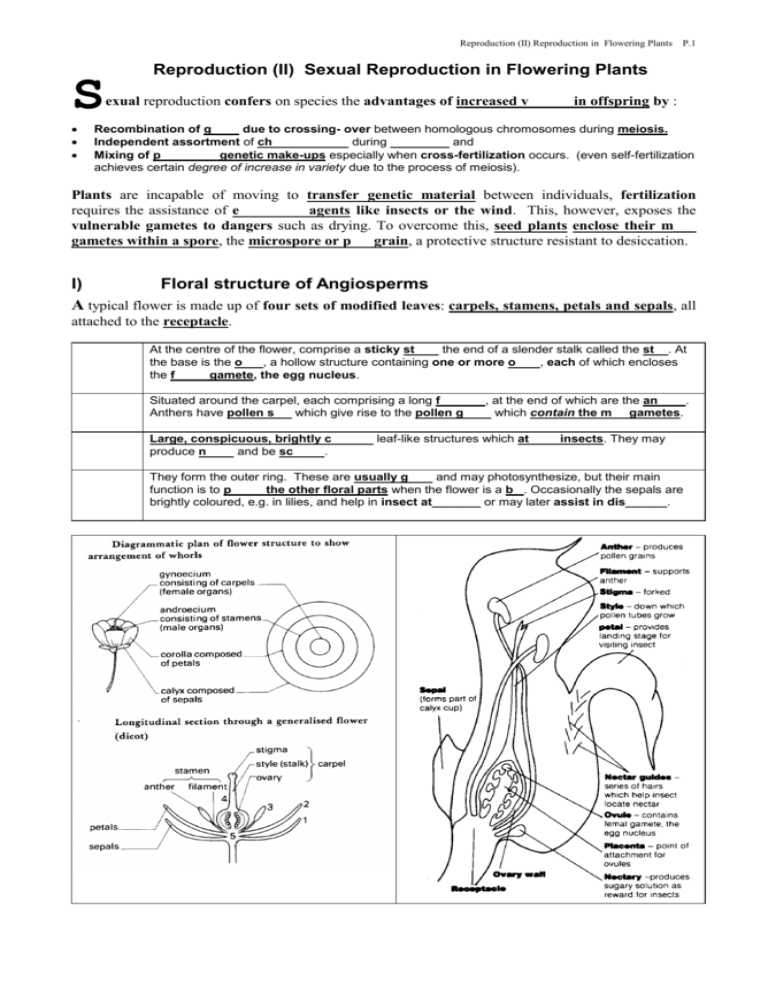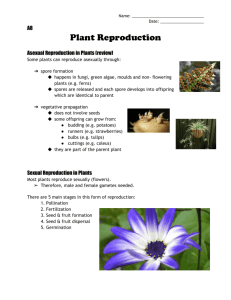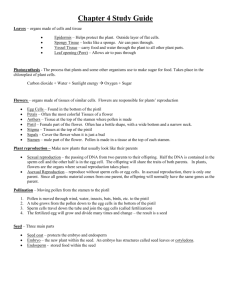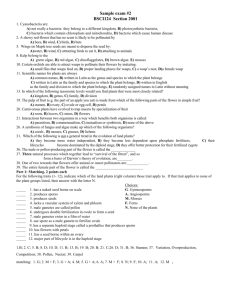V) Advantages and Disadvantages of Reproduction by Seed
advertisement

Reproduction (II) Reproduction in Flowering Plants S P.1 Reproduction (II) Sexual Reproduction in Flowering Plants exual reproduction confers on species the advantages of increased v in offspring by : Recombination of g due to crossing- over between homologous chromosomes during meiosis. Independent assortment of ch during and Mixing of p genetic make-ups especially when cross-fertilization occurs. (even self-fertilization achieves certain degree of increase in variety due to the process of meiosis). Plants are incapable of moving to transfer genetic material between individuals, fertilization requires the assistance of e agents like insects or the wind. This, however, exposes the vulnerable gametes to dangers such as drying. To overcome this, seed plants enclose their m___ gametes within a spore, the microspore or p grain, a protective structure resistant to desiccation. I) Floral structure of Angiosperms A typical flower is made up of four sets of modified leaves: carpels, stamens, petals and sepals, all attached to the receptacle. At the centre of the flower, comprise a sticky st the end of a slender stalk called the st . At the base is the o , a hollow structure containing one or more o , each of which encloses the f gamete, the egg nucleus. Situated around the carpel, each comprising a long f Anthers have pollen s which give rise to the pollen g Large, conspicuous, brightly c produce n and be sc . , at the end of which are the an . which contain the m gametes. leaf-like structures which at insects. They may They form the outer ring. These are usually g and may photosynthesize, but their main function is to p the other floral parts when the flower is a b . Occasionally the sepals are brightly coloured, e.g. in lilies, and help in insect at_______ or may later assist in dis______. Reproduction (II) Reproduction in Flowering Plants A) P.2 Development of Pollen grains Each stamen has an anther which consists of four pollen s . Within the pollen sacs are spore m______ cells which undergoes meiosis to form 4 pollen grains1. The haploid nucleus within each pollen grain divides into two by mitosis into a g_________ nucleus and a t___ nucleus. the generative nucleus will later give rise to the two m gametes B) Development of the Embryo sac and the Female gamete Within the ovary are ovule(s), each attach to the ovary wall by the funicle. The ovule is enclosed by the integ . A small pore is left at one end of the ovule, the mic . Within the ovule, the megaspore m______ cell divides by meiosis into four haploid megaspores, three degenerate leaving one which become the haploid m , which grows into the em sac. The nucleus of the embryo sac then divides by mitosis into eight h nuclei. One of which is the f gamete (egg nucleus); two fuse to form a dip nucleus at the centre. 1Pollen grain is equivalent to microspore. Reproduction (II) Reproduction in Flowering Plants II) P.3 Pollination Pollination is the transfer of pollen from anther to stigma. The design of any individual flower is related to the precise agent used to transfer pollen. If the plant is insect-pollinated its bright colour & scent attract potential pollinating insects. Wind-pollinated flowers are dull, unattractive and without scent. With anthers & stigmas exposed to the action of wind. Comparison of Wind and Insect-pollinated flowers Wind-pollinated flowers e.g. Rye grass Flowers are often uni______ with an excess of male flowers Insect-pollinated flowers e.g. Buttercup Mostly bisexual flowers Petals are d__ and much reduced in s___ Petals are l____and b______ coloured. Insect-g____ on petals guide them to n_____ b. Landing platform for insects? No Yes, making it easy for insects to alight on the flower b. Scent or nectar produced? No s_____or n_____is produced Flowers produce scent and/or nectar to attract insects Stigmas often protrude o_____ the flower on long styles Stigmas lie deep within the corolla Stigmas relatively l_____ & f_______, giving a large s_____ area to catch pollen from the air Stigmas are relatively small as the pollen is deposited accurately by the pollinating insects Anthers dangle o_____ the flower on long filaments. Pollen is easily rel_____ into the air Lie inside corolla so pollinating insect brushes against them when collecting nectar b. Quantity of pollen produced? Enor___ amounts of pollen are produced to offset the high degree of wastage during dispersal Less pollen is produced as pollen transfer is more precise and so entails less w______ c. Powdery or does it form clumps? Smooth or rough surface? Sm____, l____, p______ and small and sometimes has 'wing-like' extensions to aid w___-transport Larger and form clumps, often rough-surfaced which help it adhere to the insect Flower unisexual or bisexual? Petals a. Large & attractive? Stigmas a. Hanging outside the flower ? b. Feathery or sticky? Anthers and pollen grains a. Anthers hanging outside the flower ? Reproduction (II) Reproduction in Flowering Plants III) P.4 Fertilization On landing on the stigma the pollen grains absorb water and ger_____ to give the pollen tube. The tube2 pushes between the loosely packed cells of the s___, the t___ nucleus preceding the male nuclei. On entering the embryo sac the tube nucleus degenerates and the two male n_____ enter. One male nucleus fuses with the egg cell to give a diploid z . The other fuses with the two polar nuclei to form the primary e_________ nucleus, which is therefore t________. This d fertilization is unique to flowering plants. 2The tube shows a positive chemotropic response to some substance produced in the embryo sac. The secretion of pectinases by the pollen tube may soften the middle lamellae of the cells in the style and so assist its growth towards the micropyle. The role of the tube nucleus is to control the growth of the pollen tube and it plays no part in fertilization. Reproduction (II) Reproduction in Flowering Plants P.5 Methods to prevent self-pollination / Inbreeding There can be no doubt that in some plants self-pollination occurs more or less regularly. However, there appears to be a general tendency to avoid self-pollination since this is a form of inbreeding and would very quickly reduce the variability of a population. The stamens and stigma mature at different times. If the stamens ripen before the stigma, the flower is protandrous. If the stigma and ovule ripen before the stamens, the flower is protogynous. If a plant has separate male and female flowers it is said to be monoecious, e.g. maize (Zea). This condition clearly limits the possibility of self-pollination. A dioecious species is one in which some individual plants have either all male or all female flowers. Completely dioecious plants are rare. The structure of the flower itself makes self-pollination unlikely. eg. Heterostyly in primrose. In many plants self-pollination occurs but there is a mechanism to prevent this leading to successful fertilization of the ovule and production of a seed. e.g. genetically determined incompatibility. Q. The figure shows two types of primrose flower. They occur naturally in roughly equal numbers and differ in length of style (heterostyly) and position of anthers. a) Given that bees collect nectar from the base of the corolla tube, explain how cross-pollination between pin-eyed and thrum-eyed flowers rather than between flowers of the same type, is favoured. b) What is the advantage of such a system? IV) Development of Fruits and Seeds Following fertilization, the zygote divides rapidly by m____ and develops into the e , which consists of a young shoot, called the pl______, a young root, the ra______ and seed leaves known as c_________. The primary endosperm nucleus also divides mitotically to give a mass of cells, the en . This forms the food source for the growing embryo. In some species, e.g. maize (Zea mays), the endosperm remains while in others, e.g. peas, it is quickly absorbed by and stored in the cotyledons. The most common food stores in seeds is c__________. This is usually in the form of starch but some seeds, e.g. maize and peas, store quantities of sugar. L____ may form a high percentage of the dry weight, e.g. 60% in walnuts and coconuts; 40% in sunflowers. P_____ are found to a lesser extent in seeds but wheat has an aleurone layer and protein is stored in the cotyledons of legumes. Fate of parts of ovule after fertilization PARTS Zygote OF Primary endosperm nucleus OVULE Integuments embryo (plumule, radicle, one or two cotyledons--may or may not store food) endosperm (may or may not persist as a food store) testa (seed coat) Reproduction (II) Reproduction in Flowering Plants P.6 Distinguishing seeds from fruits Seed Fruit Origin a fertilised ovule Scar one scar - funicle stalk an ovary containing one or more fertilized ovule / seeds two scars - receptacle and styles Wall seed coat / testa develop from integument ovary wall becomes the pericarp (fruit wall) V) Advantages and Disadvantages of Reproduction by Seed The seed is the product of sexual reproduction in seed plants, it is a fertilised ovule. It contains an embryo plant with one or more cotyledons, sometimes an endosperm, and is surrounded by a protective testa. Advantages The seed p______ the embryo. The seed contains f____ for the embryo (either in cotyledons or in the endosperm). The seed is usually adapted for d________. The seed can remain d_______ and survive adverse conditions. The seed is physiologically s________ to favourable conditions and sometimes must undergo a period of after-ripening so that it will not germinate immediately. As a product of sexual reproduction, seeds have the attending advantages of genetic v_________. Disadvantages Seeds are relatively large structures because of the extensive food reserves. This makes d________ more difficult than by spores. Seeds are often e_____ by animals for their food reserves. There is a reliance on external a_____ such as wind, insects and water for pollination. This makes pollination (and hence fertilisation) risky, particularly wind pollination. There is a large w______ of seeds because the chances of survival of a given seed are limited. Plants must therefore invest large quantities of material and energy in seed production to ensure success. The food supply in a seed is l______, whereas in vegetative propagation food is available from the parent plant until the daughter plant is fully established. Two individuals are required in dioecious species making the process more r___ than reproduction in which only one parent is involved. However, dioecious plants are relatively rare. Reproduction (II) Reproduction in Flowering Plants V) P.7 Fruit and seed dispersal After seed development either the entire fruit or the seed(s) contained within it are dispersed from the parent sporophyte. If the peri____ (wall) of the fruit becomes hard and dry it is called a dry fruit and if it becomes fleshy, a succulent fruit. Why is dispersal necessary ? Sexual reproduction generally ensures var . New genotypes are produced with the potential to survive in d habitats. If this potential is to be realized it is essential that fruits and seeds are dispersed to new areas with different environmental conditions. A degree of isolation also reduces the chances of backcrossing with the parents and eliminates all the problems that in_________ incurs. Dispersal prevents over and makes species less vulnerable to epidemic att a) and competition by viruses, fungi and insects. Wind Dispersal These include modifications that increase the fruit’s or seed’s s area and so present more re_________ to the wind. This delays its descent and the longer it is airborne the further it is carried. eg pericarp is extended to form a wing; in dandelion a pappus of hair forms a 'p_________', b) Animal Dispersal The fruit or seed may develop hooks which catch in the fur of animals. These hooks may be extensions of the pericarp, e.g. goosegrass. Alternatively the fruit may be eaten by an animal and the seeds, which are resistant to digestion, later pass out in faeces . These fruits, e.g. cherry and blackberry, are usually brightly coloured. Reproduction (II) Reproduction in Flowering Plants c) P.8 Water Dispersal This occurs in a few species, e.g. water-lily and coconut, living in or near water. The seed is covered in a spongy or fibrous layer which traps air, making the seed or fruit buoyant. d) Mechanical Dispersal The fruit may remain attached to the plant but open violently to expel the seeds. This is usually caused by the unequal drying of the pericarp and occurs in all legumes, e.g. pea END








